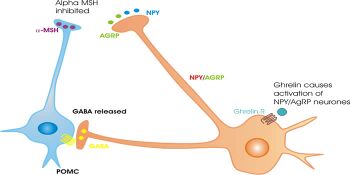Ghrelin
Ghrelin is a hormone produced by P/D1 cells lining the fundus of the human stomach that stimulate appetite [1]. In rodents, X/A-like cells produce ghrelin. The discovery of ghrelin was reported by Kojima et al. in 1999. [2] The name is based on its role as a growth hormone-releasing peptide, with reference to the Proto-Indo-European root ghre, meaning to grow. Originally identified as the endogenous ligand for the 'growth hormone secretaguge (GHS) receptor, it was first thought to be mainly involved in the regulation of growth hormone secretion from the anterior pituitary gland; however, it was soon found to be a potent orexigen. Plasma concentrations of ghrelin increase progressively before meals and decrease after meals. In some respects it can be considered as a counterpart of the hormone leptin, produced by adipose tissue, which suppresses appetite.
Receptors for ghrelin are expressed in the anterior pituitary and in several areas of the central nervous system, but at particularly high densities by neurons in the arcuate nucleus and the ventromedial hypothalamus. The ghrelin receptor is a G-protein coupled membrane receptor, formerly known as the GHS receptor (growth hormone secretagogue receptor). There is also evidence that ghrelin may also be made by a small population of neurons in the arcuate nucleus.
In rats, ghrelin increases food intake and increases fat mass (adiposity) [3][4] as a result of its actions at the hypothalamus. Sustemic injections of ghrelin activate cells in the arcuate nucleus[5][6] including the orexigenic neuropeptide Y (NPY) neurons, as well as the neuroendocrine neurons that secrete growth-hormone releasing hormone.[7] Ghrelin-responsiveness of these neurones is both leptin- and insulin-sensitive.[8] Ghrelin also activates the mesolimbic cholinergic-dopaminergic reward link, a neural circuit that communicates the hedonic and reinforcing aspects of natural rewards, including food, as well as of addictive drugs, such as alcohol.[9][10]
Ghrelin exists in an inactive (pure peptide) and an active (octanoylated) form (see Hexatropin). Other side chains than octanoyl were also observed.
Relation to obestatin
Obestatin is a hormone that was found, in late 2005, to decrease appetite. Both obestatin and ghrelin are encoded by the same gene; the gene's product breaks apart to yield the two peptide hormones [12]. The purpose of this mechanism is unknown.
References
- ↑ Bowers C et al.
- ↑ Kojima M et al. (1999) Ghrelin is a growth-hormone-releasing acylated peptide from stomach. Nature 402:656-60. PMID 10604470.
- ↑ Lall S et al. (2001). "Growth hormone (GH)-independent stimulation of adiposity by GH secretagogues". Biochem Biophys Res Commun 280: 132–8. DOI:10.1006/bbrc.2000.4065. PMID 11162489. Research Blogging.
- ↑ Tschöp M et al. (2000). "Ghrelin induces adiposity in rodents". Nature 407: 908–13. DOI:10.1038/35038090. Research Blogging.
- ↑ Hewson AK, Dickson SL (2000). "Systemic administration of ghrelin induces Fos and Egr-1 proteins in the hypothalamic arcuate nucleus of fasted and fed rats". J Neuroendocrinol 12: 1047–9. DOI:10.1046/j.1365-2826.2000.00584.x. PMID 11069119. Research Blogging.
- ↑ Dickson SL et al. (1993). "Systemic administration of growth hormone-releasing peptide activates hypothalamic arcuate neurons". Neuroscience 54: 303–6. DOI:10.1016/0306-4522(93)90197-N. PMID 8492908. Research Blogging.
- ↑ Dickson SL, Luckman SM. (1997). "Induction of c-fos messenger ribonucleic acid in neuropeptide Y and growth hormone (GH)-releasing factor neurons in the rat arcuate nucleus following systemic injection of the GH secretagogue, GH-releasing peptide-6". Endocrinology 138: 771–7. DOI:10.1210/en.138.2.771. PMID 9003014. Research Blogging.
- ↑ Hewson AK et al. (2002). "The rat arcuate nucleus integrates peripheral signals provided by leptin, insulin, and a ghrelin mimetic". Diabetes. 51: 3412–9. pmid=12453894. DOI:10.2337/diabetes.51.12.3412. Research Blogging.
- ↑ Jerlhag E et al. (2004). "Ghrelin stimulates locomotor activity and accumbal dopamine-overflow via central cholinergic systems in mice: Implications for its involvement in brain reward". Addiction Biol 11: 45–54. DOI:10.1111/j.1369-1600.2006.00002.x. PMID 16759336. Research Blogging.
- ↑ Jerlhag E et al. (2007). "Ghrelin administration into tegmental areas stimulates locomotor activity and increases extracellular concentration of dopamine in the nucleus accumbens". Addiction Biol 12: 6–16. DOI:10.1111/j.1369-1600.2006.00041.x. PMID 17407492. Research Blogging.
- ↑ Hewson AK et al. (2002). "The rat arcuate nucleus integrates peripheral signals provided by leptin, insulin, and a ghrelin mimetic". Diabetes 51: 3412–9.. DOI:10.2337/diabetes.51.12.3412. PMID 12453894. Research Blogging.
- ↑ Zhang et al. (2005)
- Garcia JM et al' (2005) Active ghrelin levels and active to total ghrelin ratio in cancer-induced cachexia." J Clin Endocrinol Metab 90:2920-6. PMID 15713718.
- Yildiz BO et al. (2004) "Alterations in the dynamics of circulating ghrelin, adiponectin, and leptin in human obesity." Proc Natl Acad Sci U S A 101:10434-9. PMID 15231997.
- Cummings DE, et al. (2002) Plasma Ghrelin Levels after Diet-Induced Weight Loss or Gastric Bypass Surgery. New England Journal of Medicine 346:1623-1630.
- Zhang JV et al. (2005) Obestatin, a peptide encoded by the ghrelin gene, opposes ghrelin's effects on food intake. Science 310:996-999. PMID 16284174.
